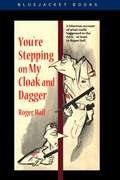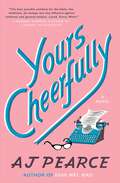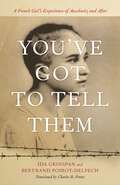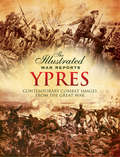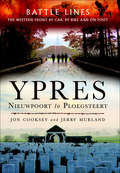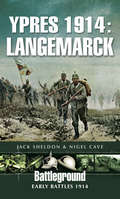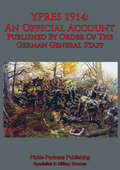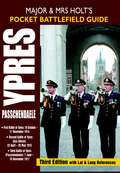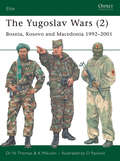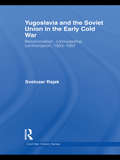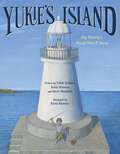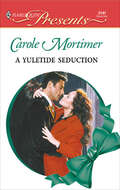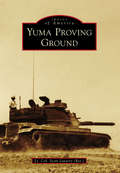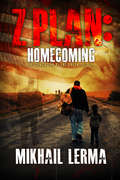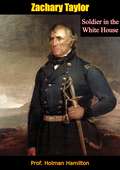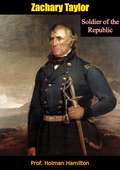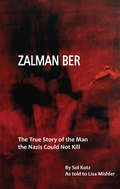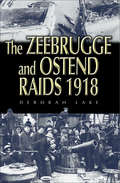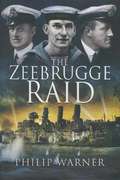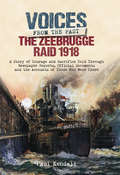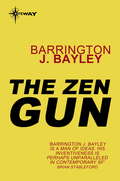- Table View
- List View
You're Stepping on My Cloak and Dagger
by Roger HallWith a sharp eye and wry wit, Roger Hall recounts his experiences as an American Army officer assigned to the Office of Strategic Services (OSS) during World War II. First published in 1957 to critical and popular acclaim, his book has become a cult favorite in intelligence circles. The story follows Hall's experiences from a junior officer fleeing a tedious training assignment in Louisiana to his quirky and rigorous OSS training rituals in the United States, England, and Scotland. Quick to pick up on the skills necessary for behind-the-lines intelligence work, he became an expert instructor. But he was only reluctantly given operational duties because of his reputation as an iconoclast. In his droll story-telling style, Hall describes his first parachute jump in support of the French resistance as a comedy of errors that terminated prematurely. His last assignment in the war zone came when William Colby appointed him section head of an operations group that made its way on foot through Sweden. Called one of the funniest and most perceptive works ever written about life in the OSS, the book includes a wealth of unforgettable personalities that Hall encountered over the years.
Yours Cheerfully: A Novel (The Emmy Lake Chronicles #2)
by AJ PearceFrom the author of the &“jaunty, heartbreaking winner&” (People) and international bestseller Dear Mrs. Bird, a new charming and uplifting novel set in London during World War II about a plucky aspiring journalist.London, November 1941. Following the departure of the formidable Henrietta Bird from Woman&’s Friend magazine, things are looking up for Emmeline Lake as she takes on the challenge of becoming a young wartime advice columnist. Her relationship with boyfriend Charles (now stationed back in the UK) is blossoming, while Emmy&’s best friend Bunty, still reeling from the very worst of the Blitz, is bravely looking to the future. Together, the friends are determined to Make a Go of It. When the Ministry of Information calls on Britain&’s women&’s magazines to help recruit desperately needed female workers to the war effort, Emmy is thrilled to be asked to step up and help. But when she and Bunty meet a young woman who shows them the very real challenges that women war workers face, Emmy must tackle a life-changing dilemma between doing her duty and standing by her friends. Every bit as funny, heartwarming, and touching as Dear Mrs. Bird, Yours Cheerfully is a celebration of friendship—a testament to the strength of women and the importance of lifting each other up, even in the most challenging times.
You’ve Got to Tell Them: A French Girl's Experience of Auschwitz and After
by Ida Grinspan Bertrand Poirot-Delpech Charles B. PotterOn a quiet winter night in 1944, as part of their support of the Third Reich’s pogrom of European Jews, French authorities arrested Ida Grinspan, a young Jewish girl hiding in a neighbor’s home in Nazi-occupied France. Of the many lessons she would learn after her arrest and the subsequent year and a half in Auschwitz, the most notorious concentration camp of the Holocaust, the first was that “barbarity enters on tiptoes . . . [even] in a hamlet where everything seemed to promise the peaceful slumber of places forgotten by history.”Translated by Charles B. Potter, You’ve Got to Tell Them is the result of a friendship that formed in 1988, when Grinspan returned to visit Auschwitz for the first time since 1945 and where she met Bertrand Poirot-Delpeche, a distinguished writer for the Paris newspaper Le Monde. Sometimes speaking alone, sometimes speaking in close alternation, Grinspan and Poirot-Delpeche simultaneously narrate the story of her survival and the decades that followed, including how she began lecturing in schools and guiding groups that visited the death camps. Replete with pedagogical resources including a discussion of how and why the Holocaust should be taught, a timeline, and suggestions for further reading, Potter’s expert translation of You’ve Got to Tell Them showcases a clear and moving narrative of a young French girl overcoming one of the darkest periods in her life and in European history.
Ypres: Contemporary Combat Images from the Great War (The Illustrated War Reports)
by Bob CarruthersThis powerful collection, depicting the grim realities of the four-year struggle for the Ypres salient, showcases the work of the contemporary combat artists and illustrators from the Great War era. Included here are the works of serious artists, propagandists, illustrators and humourists. The result is a stunning and vivid graphic record of life and death in the most infamous campaign of the Great War, as reported to contemporary audiences at a time when the events of the Great War were still unfolding. During the Great War artists and illustrators produced a highly accurate visual record of the fleeting moments the bulky cameras couldn't reproduce. These works form a body ofwar reportage that are as valid as the written word. Today, the work of the combat illustrators and the official war artists from the Great War era is overlooked by historians in favour of photographs, but these illustrations are nonetheless important, as they provide a contemporary record of hand-to-hand fighting, trench raids, aerial dogfights, sea battles, desperate last stands, night actions and cavalry charges
Ypres: Nieuwpoort to Ploegsteert (Battle Lines: The Western Front By Car, By Bike and On Foot)
by Jon Cooksey Jerry MurlandBattle Lines Ypres, the first volume in Pen & Swords new series of walking, cycling and driving guides to the Western Front, is the essential companion for every visitor to the Ypres Salient and the battlefields of Belgium. Many of the most famous - and most memorable - Great War sites are featured here. Expert guides Jon Cooksey and Jerry Murland take visitors over a series of routes that can be walked, biked, or driven, explaining the fighting that occurred in each place in vivid detail. They describe what happened, where it happened, and why, and who was involved, and point out the sights that remain there for the visitor to see. Their accounts give a fascinating insight into the landscape of the front line and the acts of war that took place there a century ago.
Ypres 1914: Langemarck (Battleground Early Battles 1914 Ser.)
by Nigel Cave Jack SheldonThese three Battleground Europe books on Ypres 1914 mark the centenary of the final major battle of the 1914 campaign on the Western Front. Although fought over a relatively small area and short time span, the fighting was even more than usually chaotic and the stakes were extremely high. Authors Nigel Cave and Jack Sheldon combine their respective expertise to tell the story of the men British, French, Indian and German - who fought over the unremarkable undulating ground that was to become firmly placed in British national conscience ever afterwards.When, in October 1914, the newly created German Fourth Army attacked west to seize crossings over the Yser, prior to sweeping south in an attempt to surround the BEF, two things prevented it. To the north, it was the efforts of the Belgian army, reinforced by French troops, coupled with controlled flooding of the polders but, further south, the truly heroic defence of Langemarck, for three days by the BEF and then by the French army, was of decisive importance. The village stood as a bulwark against any further advance to the river or the town of Ypres. Here the German regiments bled to death in the face of resolute Allied defence and any remaining hope of forcing a decision in the west turned to dust.
YPRES 1914: An Official Account Published By Order Of The German General Staff
by The German General Staff"An official German account, written close to the action, of the early Great War battles of the Yser and first Ypres in the autumn of 1914. Interesting revelation of German attitudes to the two battles that stopped their steamroller advance through Flanders.The full title of this book is "The Battle of the Yser and of Ypres in the Autumn 1914" and it gives equal coverage to both. It was written by a Captain Otto Schwink, a General Staff Officer, in 1917 - too close in time to the operations it describes to have permitted proper research and so provide a more objective account. It was intended primarily for public consumption and was how the German General Staff wished the campaign to be seen. Nevertheless, it is interesting to read the other side's point of view and balance is to some extent restored by the series of footnotes provided throughout the narrative by our own Historical Section (Military Branch)."--N&M Press Reprint
Ypres Passchendaele: 1st Ypres; 2nd Ypres (Gas Attack); 3rd Ypres (Passchendaele) 4th Ypres (The Lys) (Major & Mrs Holt's Pocket Battlefield Guide)
by Tonie Holt Valmai HoltA guide to these historic Belgian landmarks of the First World War, with maps and photos. Covering the Battles of Ypres, including the notorious Passchendaele, this guidebook takes readers on a historic trip through some of the best-known and most important sites of the area in Belgium. Part of a series of guides, it serves as an introduction to the historic battlefields, whether on the ground or from an armchair. Included are selections from the Holts' more detailed guides of the most popular and accessible sites, many full color maps and photographs, and detailed instructions on what to see and where to visit.
The Yugoslav Wars
by Darko Pavlovic Nigel Thomas K. MikulanOsprey's examination of Bosnia, Kosovo and Macedonia's involvement in the Yugoslav Wars (1991-1995), as well as their involvement in the conflicts of the years that followed. Following the death of the Yugoslavian strongman President Tito in 1980, the several semi-autonomous republics and provinces that he had welded into a nation in 1945 moved inexorably towards separation. As the world watched a series of wars ripped through this modern European state. In this second of two volumes, experts on the Balkan region give an unprecedented, clear and concise explanation of the armies of the the Bosnian Civil War 1992-5 as well as the conflicts in Kosovo and Macedonia. This includes the regular and militia forces which fought in these campaigns and which ultimately resulted in the UN/NATO policing of the region that continues to this day. The book is illustrated with rare photos and an extraordinary range of colour uniform plates.
Yugoslavia and the Soviet Union in the Early Cold War: Reconciliation, comradeship, confrontation, 1953-1957 (Cold War History)
by Svetozar RajakThis book provides a comprehensive insight into one of the key episodes of the Cold War – the process of reconciliation between Yugoslavia and the Soviet Union. At the time, this process had shocked the World as much as the violent break-up of their relations did in 1948. This book provides an explanation for the collapse of the process of normalization of Yugoslav-Soviet that occurred at the end of 1956 and the renewal of their ideological confrontation. It also explain the motives that guided the two main protagonists, Josip Broz Tito of Yugoslavia and the Soviet leader Nikita Sergeevich Khrushchev. Based on Yugoslav and Soviet archival documents, this book establishes several innovative theories about this period. Firstly, that the significance of the Yugoslav-Soviet reconciliation went beyond their bilateral relationship. It had ramifications for relations in the Eastern Bloc, the global Communist movement, and on the dynamics of the Cold War world at its crucial juncture. Secondly, that the Yugoslav-Soviet reconciliation brought forward the process of de-Stalinization in the USSR and in the Peoples’ Democracies. Thirdly, it enabled Khrushchev to win the post-Stalin leadership contest. Lastly, the book argues that the process of Yugoslav-Soviet reconciliation permitted Tito to embark, together with Nehru of India and Nasser of Egypt upon creating the new entity in the bi-polar Cold War world – the Non-aligned movement. This book will be of interest to students of Cold War History, diplomatic history, European history and International Relations in general. Svetozar Rajak is a lecturer at the London School of Economics and Political Science. He is the Managing Director of the LSE Cold War Studies Centre and is a member of the Editorial Board of the journal Cold War History.
Yugoslavia in the Shadow of War
by John Paul NewmanThe Yugoslav state of the interwar period was a child of the Great European War. Its borders were superimposed onto a topography of conflict and killing, for it housed many war veterans who had served or fought in opposing armies (those of the Central Powers and the Entente) during the war. These veterans had been adversaries but after 1918 became fellow subjects of a single state, yet in many cases they carried into peace the divisions of the war years. John Paul Newman tells their story, showing how the South Slav state was unable to escape out of the shadow cast by the First World War. Newman reveals how the deep fracture left by war cut across the fragile states of 'New Europe' in the interwar period, worsening their many political and social problems and bringing the region into a new conflict at the end of the interwar period.
Yukie's Island: My Family's World War II Story
by Yukie Kimura Kōdo Kimura Steve SheinkinA moving picture book autobiography about a family’s resilience and path to healing after the devastation of war. It's 1945, the final year of World War II. Yukie Kimura is eight years old. She lives on a tiny island with a lighthouse in the north of Japan with her family, and she knows that the fighting that once felt so far away is getting closer. Mornings spent helping her father tend to the lighthouse and adventuring with her brother are replaced by weeks spent inside, waiting. At some point, Yukie knows, they may be bombed. Then, it happens. One Sunday, bombs are dropped. The war ends soon after that. Everyone tells Yukie there's nothing to be scared of anymore, but she's not so sure. So she watches and she waits—until a miraculous sight finally allows her to be a kid again. This is the true story of Yukie Kimura told in her own words, co-created with her son, illustrator Kodo Kimura, and co-written with bestselling Newbery Honor author Steve Sheinkin. Yukie's Island is an honest, thoughtful, and stirring picture book about being a child living through wartime.
A Yuletide Seduction (Christmas Ser. #17)
by Carole MortimerEverybody knows her as Jane Smith—a successful businesswoman. What they don’t know is that Jane has also successfully distanced herself from her past.Until she meets handsome American Gabriel Vaughan at a Christmas party. Gabe’s determined to get close to her, seduce her and sooner or later he’ll recognize her…as a former society lady with a secret…
Yuma Proving Ground (Images of America)
by Lt. Col. (Ret.)The Yuma Proving Ground's early history began in 1849 with the establishment of Army outposts in the region. When the United States entered World War II in 1942, the Army established a large-scale training center that expanded from eastern California into western Arizona. Gen. George S. Patton Jr. was assigned to develop the Desert Training Center as a location to train personnel and test equipment in the harsh desert for the war effort. As part of the Desert Training Center, Camp Laguna and the Yuma Test Branch were founded to conduct specific training and testing in support of the war effort. In 1951, the Yuma Test Branch was renamed the Yuma Test Station, and by 1957, the Army began training personnel on military freefall. In 1963, the Army renamed the Yuma Test Station as the Yuma Proving Ground. Today, the Yuma Proving Ground stands near the original sites with the continued task of testing equipment and training personnel.
Z
by Vassilis VassilikosThe story of a political murder and the corruption of a ruthless and powerful military regime in a novel charged with anger, passion and suspense.
Z Plan: Homecoming (Z Plan Trilogy #3)
by Mikhail LermaAfter surviving an odyssey through zombie hordes, an American soldier faces the ultimate trial as he returns home in this apocalyptic series finale. Facing death and fighting the undead, Cale has made a seemingly impossible journey through the Iraqi desert and across dangerous oceans. All the while, he dreamed of reaching his home in America. Now, as that dream finally comes true, Cale discovers a nightmarish reality.In the thrilling conclusion of the Z Plan Trilogy, Cale’s limits are put to the final test as he pushes his way through the undead. But something even more sinister follows his every move. In a world where the weak die and every glimmer of hope seems extinguished, Cale’s toughest challenge will be to overcome his inner demons.
Zachary Taylor: Soldier in the White House (Zachary Taylor #2)
by Prof. Holman HamiltonThis tome is the second volume of Holman Hamilton’s landmark biography of Zachary Taylor (1784-1850), the 12th President of the United States. It examines Taylor’s brief but important political career and traces Taylor’s life from his return to the U.S. in December of 1847 from the bloody Mexican battlefields, to his death on July 9, 1850, a mere sixteen months after assuming the office of the presidency.As interesting as the history surrounding Zachary Taylor’s life is the man himself. Taylor was no politician. Throughout his life, he never voted in an election. He knew little of the party that nominated him. And he candidly admitted no opinion on certain political questions, and on others was reluctant to comment at all. At the end of his famous Allison letter that secured him the presidency in 1848, he stated: “I do not know that I again shall ever write upon the subject of national politics.” How and why he was elected President are just some of the questions that Hamilton answers about one of America’s most unusual presidencies.Zachary Taylor: Soldier in the White House is the sequel to Zachary Taylor Soldier of the Republic. Together, both volumes represent what is considered by historians to be the definitive biography of the 12th President of the U.S. Lauded for his meticulous research and highly readable style, the late Holman Hamilton, a noted journalist and editor, set out to “write entertainingly and even artistically about men and events in the realm of actuality.” Both volumes of this extraordinary biography are ample proof that he accomplished his goal.
Zachary Taylor: Soldier of the Republic (Zachary Taylor #1)
by Prof. Holman HamiltonUntil the publication of this first volume in 1941, Zachary Taylor (1784-1850), the 12th President of the United States, was strangely overlooked by modern-day biographers. Fortunately, journalist and newspaper editor Holman Hamilton has ably rectified this situation, and filled a large gap in the biographical record of American presidential history with this stirring account of the life and times of “Old Rough and Ready.”Zachary Taylor: Soldier of the Republic is the first volume of Hamilton’s two-volume biography. It covers the entire span of Taylor’s military career from his earliest service in Indian warfare on the fringe of the frontier, to his great triumphs on bloodstained Mexican battlefields.Here is the story of 40 years of preparation for the brief period of glory in which Taylor was elevated to fame as 12th President of the United States: his presidency lasted a mere 16 months. Here too, for the first time, is the true romantic story of the courtship and marriage of Taylor’s daughter and Jefferson Davis. All is set in a framework of American life on the advancing western frontier from 1820 to 1845.In preparation for this work, Holman Hamilton undertook extensive research, exploring many untapped resources, including unpublished manuscripts, rare volumes of western travel, original newspaper accounts, and many obscure records from the archives of the Library of Congress and the War Department. He also researched many of the Taylor family’s personal papers, letters and memories. Finally, in the true tradition of investigative journalism, Hamilton personally traveled Taylor’s “trail,” and visited every Taylor battleground—from Indiana to Florida, Wisconsin to Mexico—to give this biography an authenticity unmatched in detail or color.
Zalman Ber: The True Story of the Man the Nazis Could Not Kill
by Lisa Mishler Sol KotzZalman Ber's story, told in his own voice, is a powerful addition to the historical recountings of World War II. Together, he and his wife, Luba, survived the Holocaust. They escaped the horrors the Nazis inflicted on their Polish villages. They fought with partisans. Then later, Zalman enlisted with the Russian military. Their story is about love, war, heroism, and miracles. It is a testament to their resiliency and capacity not just to survive, but to flourish and rise above tremendous adversity. Love, courage, and a sheer force of will drove Luba during her long journey to find Zalman, alone, in one of the coldest winters in recorded history while being surrounded by Nazi soldiers. Luba with her sensitivity influenced Zalman when, time and time again, he should have been killed and was not. Their story deserves to be experienced and honored.
Zarifa: A Woman's Battle in a Man's World
by Zarifa Ghafari Hannah Lucinda SmithA poignant memoir by one of Afghanistan's youngest female mayors and the inspiration behind the upcoming Netflix documentary, In Her Hands, executive produced by Hilary Rodham Clinton and Chelsea Clinton. Zarifa Ghafari was three years old when the Taliban banned girls from schools, and she began her education in secret. She was six when American airstrikes began. She was twenty-four when she became mayor – one of the first female mayors in the country – and first of Wardak, one of the most conservative provinces in Afghanistan. An extremist mob barred her from her office; her male staff walked out in protest; assassins tried to kill her three times. Through it all, Zarifa stood her ground. She ended corruption in the municipality, promoted peace, and tried to lift up women, despite constant fear for herself and her family. When the Taliban took Kabul in 2021, Ghafari had to flee. But even that couldn&’t stop her. Six months later, she returned, to continue her work empowering women. Zarifa is an astonishing memoir that offers an unparalleled perspective of the last two decades in Afghanistan from a citizen, daughter, woman and mayor. Written with honesty, pain, and ultimately, hope, Zarifa describes the work she did, the women she still tries to help as they live under Taliban rule, and her vision for how grassroots activism can change their lives and the lives of women everywhere.
Zeebrugge and Ostend Raids (Battleground Channel Ports Ww1 Ser.)
by Deborah LakeThe unrestricted U-Boat war threatened the very survival of Britain, whose reliance on imported food and war materials was her Achilles Heel. A significant element of the German submarine fleet operated from the occupied Belgian ports of Zeebrugge and Ostend. After careful planning the Royal Navy launched audacious attacks on these two ports on St Georges Day 1918. Five obsolete cruisers and two Mersey ferries supported by a flotilla of smaller vessels penetrated the near impregnable defenses, while Royal Marines and naval storming parties battle ashore in a diversionary attack. At the time of the action the concrete filled block ships were scuttled in the ports approaches.Despite being a costly and bloody affair for the participants, the survivors returned to acclaim. The raids gave a fillip to the national morale, at a time of depressing news from the Front. To underline the success of the affair no less than 11 Victoria Crosses were awarded.
The Zeebrugge Raid
by Philip WarnerOn 23 April 1918 a force drawn from the Royal Navy and Royal Marines launched one of the most daring raids in history. The aim was to block the Zeebrugge Canal, thereby denying U-boat access, although this meant assaulting a powerfully fortified German naval base. The raid has long been recognised for its audacity and ingenuity but, owing to the fact that the official history took overmuch notice of the German version of events, has been considered only a partial success. The error of that view is now exposed, for in this stirring account there is evidence from many sources that the raid achieved much more than is usually credited to it. The raid is presented from a variety of viewpoints, from the airmen who took part in the preliminary bombing to the motor launches which picked up survivors. The crews of the launches and coastal motor boats were frequently 'amateur' sailors but their courage and skill were second to none. Philip Warner has talked with many of the survivors and corresponded with others, some of whom now live in distant parts of the world.
The Zeebrugge Raid 1918: A Story of Courage and Sacrifice Told Through Newspaper Reports, Official Documents and the Accounts of Those Who Were There (Voices from the Past)
by Paul KendallApproximately a third of all Allied merchant vessels sunk during the First World War were by German boats and submarines based at Bruge-Zeebrugge on the coast of Belgium. By 1918 it was feared that Britain would be starved into surrender unless the enemy raiders could be stopped. A daring plan was therefore devised to sail directly into the heavily defended port of Zeebrugge and then to sink three obsolete cruisers in the harbour in the hope they would block German vessels from reaching the English Channel. The cruisers were also to be accompanied by two old submarines, which were filled with explosives to blow up the viaduct connecting the mole to the shore, whilst 200 Marines were to be landed to destroy German gun positions at the entrance to the Bruges Canal.On 23 April the most ambitious amphibious raid of the First World War was carried out, told here through a huge collection of personal accounts and official reports on the bitter fighting which saw more than 500 British casualties from the 1,700 men who took part, and saw the awarding of eight Victoria Crosses.
Zeitgemäßes über Krieg und Tod (The World At War)
by Sigmund FreudAus dem Vorwort: “Von dem Wirbel dieser Kriegszeit gepackt, einseitig unterrichtet, ohne Distanz von den großen Veränderungen, die sich bereits vollzogen haben oder zu vollziehen beginnen, und ohne Witterung der sich gestaltenden Zukunft, werden wir selbst irre an der Bedeutung der Eindrücke, die sich uns aufdrängen, und an dem Wert der Urteile, die wir bilden. Es will uns scheinen, als hätte noch niemals ein Ereignis soviel kostbares Gemeingut der Menschheit zerstört, so viele der klarsten Intelligenzen verwirrt, so gründlich das Hohe erniedrigt.”
The Zen Gun
by Barrington J. BayleyPout, the chimera, half-man, half-ape, was incorporated into one of the plants or vice versa. He was jammed into a squatting position, while the stems, entering at his buttocks, merged with his legs, his arms and his torso, emerging at knees, elbows, and through his abdomen and thorax. A large, yellow-petalled flower seemed to frame his face.It was his face that rivetted Ikematsu's attention, while the chimera squirmed in dumb distress, glaring with huge piteous eyes. For in that face, set into it as if set in pudding, was the zen gun. The gun was his face, or a part of it. The barrel pointed straight out in place of a nose... the stock merged with and disappeared into Pout's pendulous mouth. Ikematsu leaned toward the chimera. "How you loved your toy! Now it is truly yours!"
